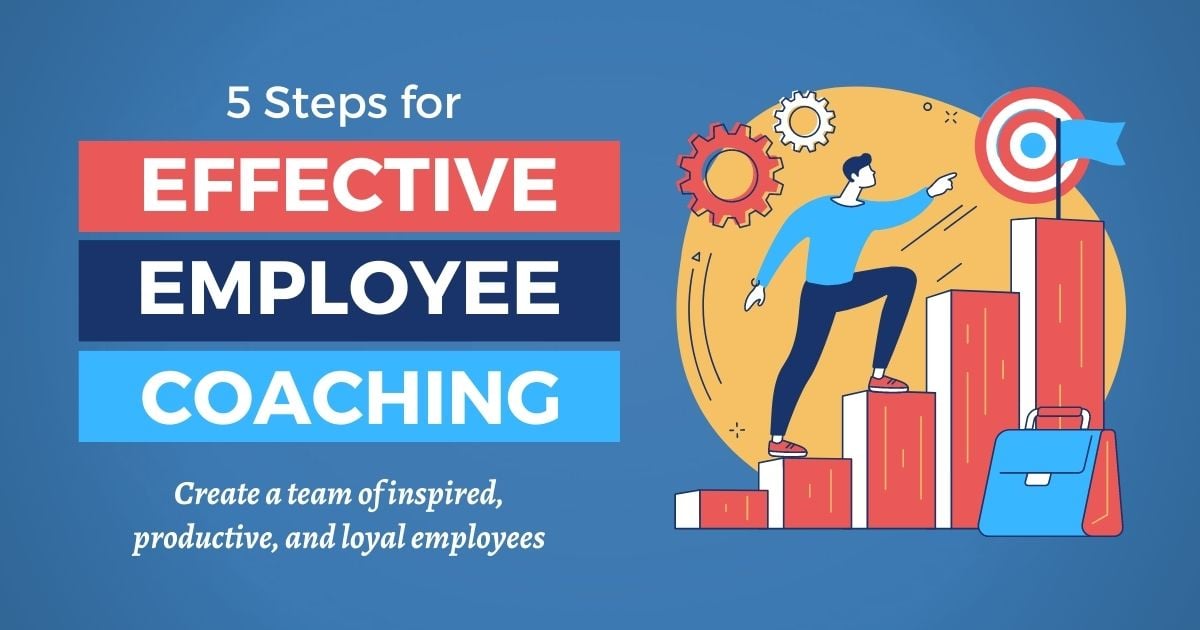
New employee orientation and job-specific training serve important purposes. Coaching, however, is a critical key that is set aside unfortunately all too often. A business owner may think that spending the time to coach is too difficult, but it is his or her leadership that helps create a great team of inspired, productive, and loyal employees.
Employee coaching involves the managers and employees meeting regularly to discuss and explore each employee's career goals and development. There are five basic steps in facilitating employees to become high-performers on your team.
Discuss the employee’s expectations of the job. Whenever a new employee is hired or an employee’s job functions change over time, always address any questions or confusion the individual may have about the job. To help confirm or clarify the employee’s perspective of the job expectations, review together a copy of the job description, department’s goals, and company’s goals.
Example: Nancy is an Office Manager with one employee – Denise as her reliable Receptionist for over the past 15 years. The nature of the firm’s clients has changed significantly, and most prefer to communicate by email – an area in which Denise has been slow to respond. Nancy updates the Receptionist job description, explains the business situation with Denise, outlines new job performance expectations (i.e. Must respond to a client’s email within one business day), and offers the employee specific email training support.
Understand the employee’s expectations of the manager. While different employees have different communication styles, learn about what each employee expects from you as a manager and come to a reasonable working agreement.
Example: Jerry, who runs an auto repair business, has an open-door policy for any of his employees to drop by with any comments. He also finds himself applying this approach whenever he feels the need to talk to his employees. Carl, his best performing technician, however, sometimes seems blatantly uninterested in whatever Jerry has to say. If left unaddressed…and likely left to fester in his mind, Jerry may not ever realize that Carl is simply not a “morning person” who really does not prefer to have early morning conversations…but who also does not mind at all reading a note or an email for him to think through and talk about later that morning.
Learn about the employee’s expectations for professional growth. Some employees work for just the paycheck, and some have specific professional development interests and ambitions. Recognizing and gathering relevant resources to help support and build a plan for each individual’s interests help strengthen employee loyalty.
Example: Beth, an excellent project scheduler for a residential home building company, is getting bored with her current job, has a very strong and creative knack for finance, and definitely wants to move in that career direction. Her supervisor, George, gets updates about important workforce changes but lags on communicating to his staff a developing plan that includes an expansion of the Finance Department. Unfortunately, since Beth never hears of such possible opportunities within the company, she starts to seek employment elsewhere.
Give feedback about the employee’s performance. Consistent and constructive feedback becomes effective when focused on raising awareness and on improving performance results.
Example: In a monthly one-on-one meeting, Aaron (the call center manager) tells Pat, “You’re doing fine!” While it sounds good, it does leave the employee with vagueness. A more helpful statement could be: “I recognize how you recently have increased your product knowledge of our widgets and, more importantly, how it has improved your answers to our customers. In fact, your customer satisfaction rating rose to 7.96 from 6.32 compared to last quarter. That’s good! Now, to get yourself to the expected minimum level of 8.00, let’s also look at other ways to help you develop further whether it’s pairing you up with our top performer, attending certain training classes…”
Get feedback about your performance. You are a manager as well as a member of a team. How well you respond to feedback from your teammates will make a significant influence on your team’s synergy and success.
Example: Consider asking the employee questions like: Which parts of my leadership style do think is effective? What areas of my management skills would you suggest changing? How can I help you become more successful in [performing a specific task, completing a particular project, achieving a defined objective, etc.]?
Always know the direction you need to take your business and the talent you need to make it happen. Each employee should come out of every formal and informal coaching meeting with a strong picture of both the specific performance goals to achieve and how his or her contributions impact the department and the company as a whole. When you make the time to commit towards helping develop your employees, you not only make an important understanding of how much you expect them but also an important impression of how much they are being valued.


